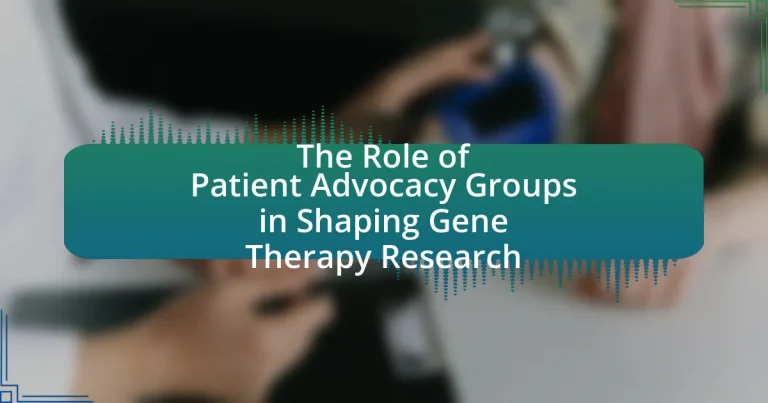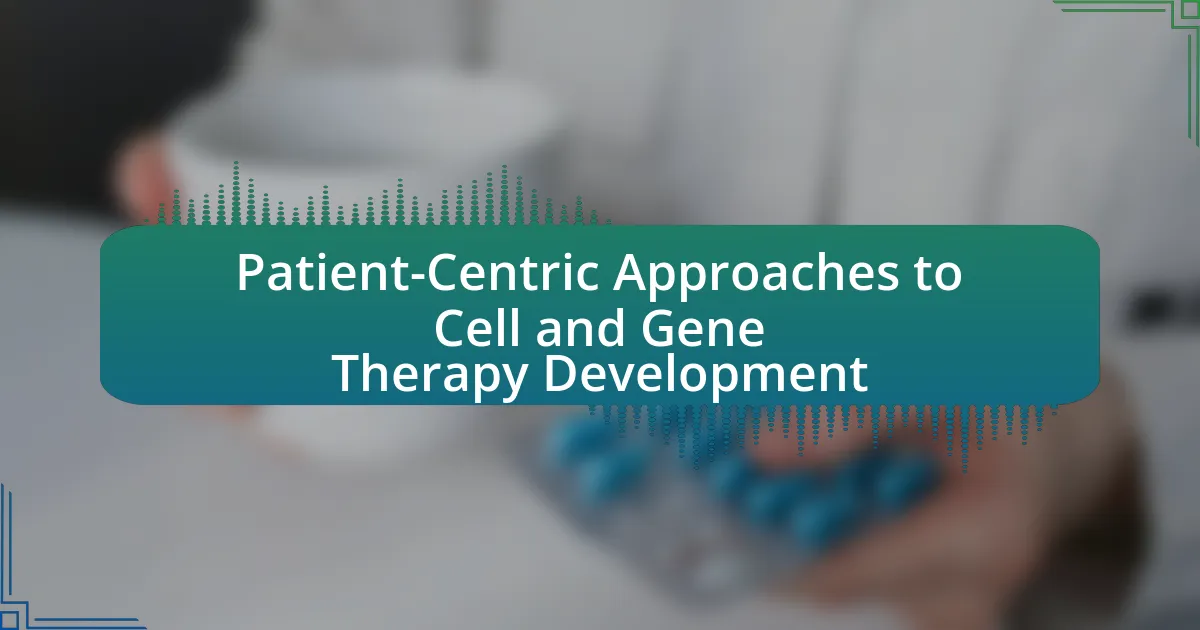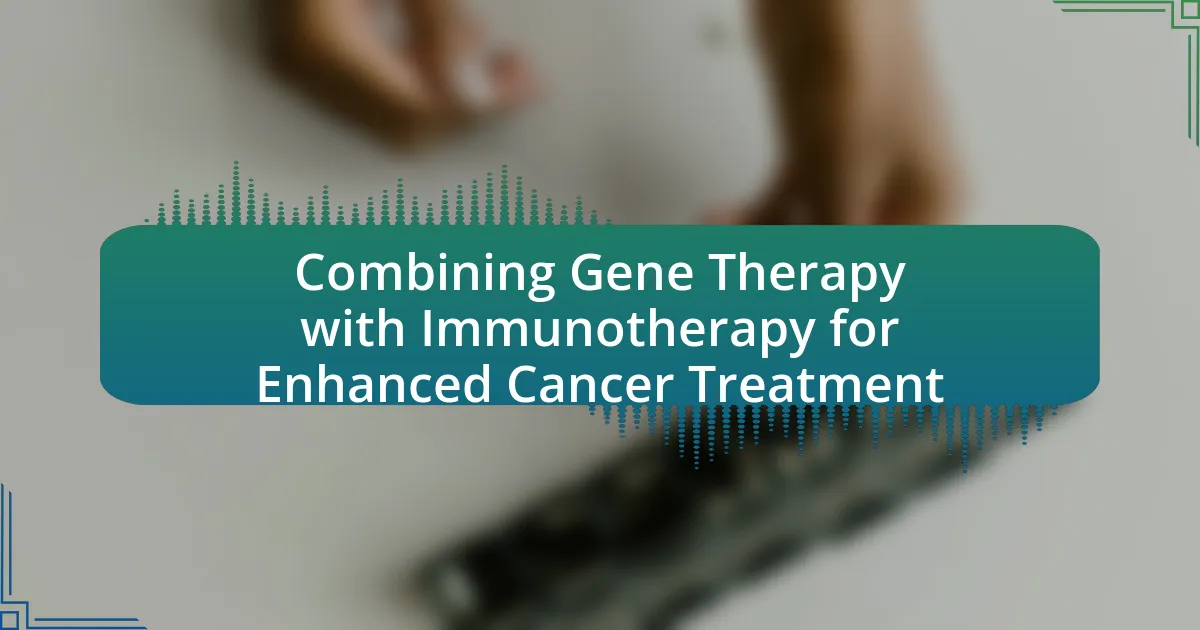Patient advocacy groups play a vital role in shaping gene therapy research by representing patient interests, influencing research priorities, and facilitating communication among stakeholders. These organizations identify specific patient needs, advocate for increased access to treatments, and promote patient-centered research, ensuring that therapies developed align with actual patient experiences. They also face challenges such as funding limitations and communication barriers with researchers, yet their collaborations with the scientific community enhance the relevance and effectiveness of gene therapies. As gene therapy evolves, the influence of patient advocacy groups is expected to grow, driving initiatives that prioritize patient perspectives in research and treatment development.
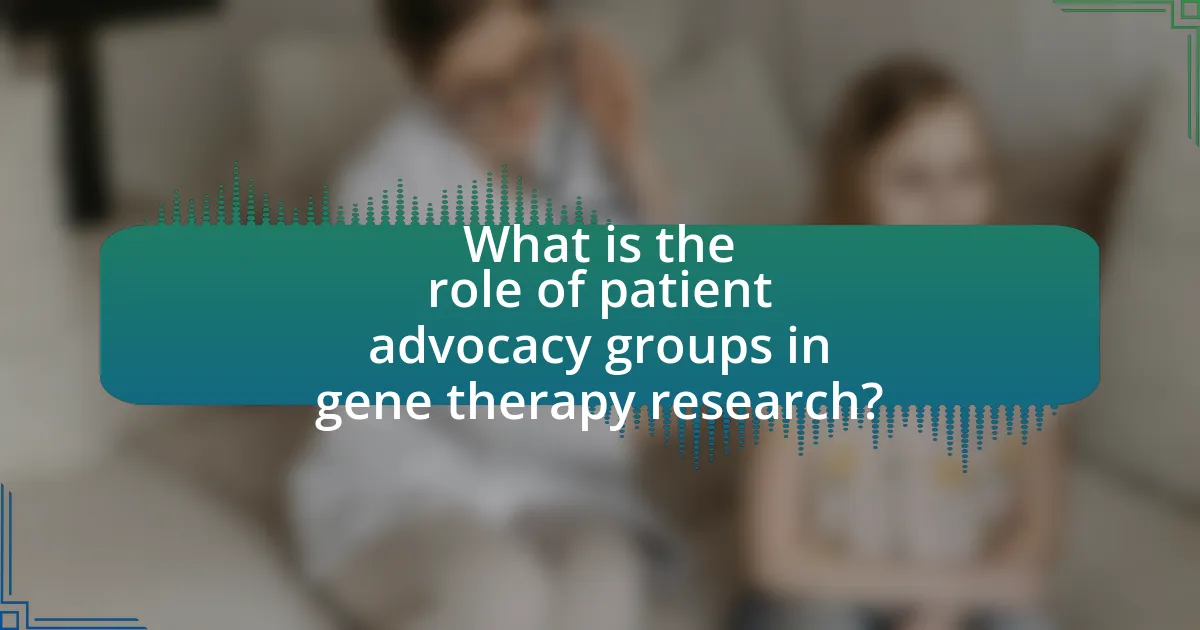
What is the role of patient advocacy groups in gene therapy research?
Patient advocacy groups play a crucial role in gene therapy research by representing the interests and needs of patients, thereby influencing research priorities and funding. These organizations facilitate communication between patients, researchers, and regulatory bodies, ensuring that patient perspectives are integrated into the development of gene therapies. For instance, advocacy groups often provide critical insights into the lived experiences of patients, which can guide the design of clinical trials and the selection of relevant endpoints. Additionally, they may mobilize funding and resources for research initiatives, as seen in collaborations like the Muscular Dystrophy Association’s support for gene therapy projects. Their involvement not only enhances the relevance of research but also accelerates the translation of scientific discoveries into effective treatments.
How do patient advocacy groups influence gene therapy research priorities?
Patient advocacy groups influence gene therapy research priorities by actively advocating for specific diseases and treatment options, thereby directing funding and research focus. These groups often represent the voices of patients and their families, highlighting unmet medical needs and pushing for the development of therapies that address those needs. For instance, organizations like the Muscular Dystrophy Association have successfully lobbied for increased research funding and collaboration with biotech companies, resulting in accelerated gene therapy projects targeting muscular dystrophies. Their efforts can lead to the prioritization of research areas that may otherwise be overlooked, ensuring that the development of gene therapies aligns with patient needs and experiences.
What specific needs do patient advocacy groups identify in gene therapy?
Patient advocacy groups identify several specific needs in gene therapy, including the necessity for increased access to treatments, comprehensive education about gene therapy options, and the importance of patient-centered research. Access to gene therapy is critical as many patients face barriers such as high costs and limited availability of therapies. Education is essential to ensure that patients and their families understand the implications, benefits, and risks associated with gene therapies. Furthermore, advocacy groups emphasize the need for research that prioritizes patient experiences and outcomes, ensuring that the development of therapies aligns with the actual needs of patients. These needs are supported by various studies highlighting the gaps in access and understanding within the patient community, underscoring the role of advocacy in addressing these challenges.
How do these needs shape research agendas in gene therapy?
Patient needs significantly shape research agendas in gene therapy by directing focus towards specific diseases and treatment modalities that require urgent attention. Advocacy groups often highlight unmet medical needs, influencing funding priorities and research directions. For instance, the advocacy for rare genetic disorders has led to increased investment in gene therapies targeting conditions like spinal muscular atrophy, as evidenced by the development of Zolgensma, which was driven by patient advocacy efforts. This alignment of research agendas with patient needs ensures that the most pressing health challenges are addressed, ultimately leading to more effective and relevant therapeutic options.
Why are patient advocacy groups important in the context of gene therapy?
Patient advocacy groups are crucial in the context of gene therapy because they amplify the voices of patients, ensuring their needs and experiences shape research priorities and treatment development. These organizations facilitate communication between patients, researchers, and regulatory bodies, fostering collaboration that can lead to more effective therapies. For instance, the advocacy efforts of groups like the Muscular Dystrophy Association have directly influenced funding and research directions in gene therapy, highlighting the importance of patient perspectives in clinical trials and regulatory processes.
What unique perspectives do patient advocacy groups bring to gene therapy research?
Patient advocacy groups bring critical perspectives to gene therapy research by representing the voices and needs of patients directly affected by genetic disorders. These groups provide insights into patient experiences, which can guide research priorities and ensure that therapies developed are relevant and beneficial to those most impacted. For instance, advocacy groups often highlight the importance of patient-centered outcomes, emphasizing the need for therapies that improve quality of life rather than just clinical endpoints. Their involvement can also facilitate communication between researchers and patients, fostering collaboration that leads to more effective and targeted gene therapies. Additionally, patient advocacy groups can mobilize funding and resources, as seen in initiatives like the Muscular Dystrophy Association’s support for gene therapy research, which underscores their role in advancing scientific inquiry and innovation.
How do patient advocacy groups enhance collaboration among stakeholders?
Patient advocacy groups enhance collaboration among stakeholders by serving as intermediaries that facilitate communication and understanding between patients, healthcare providers, researchers, and policymakers. These groups actively engage in dialogue, ensuring that patient perspectives and needs are prioritized in research and policy decisions. For instance, they organize forums and workshops that bring together diverse stakeholders, fostering a collaborative environment where shared goals can be identified and pursued. Additionally, patient advocacy groups often provide critical data and insights from the patient community, which can guide research priorities and funding allocations, ultimately leading to more effective gene therapy solutions.
What challenges do patient advocacy groups face in gene therapy research?
Patient advocacy groups face significant challenges in gene therapy research, primarily including funding limitations, regulatory hurdles, and the need for scientific expertise. Funding limitations restrict their ability to support research initiatives and patient access to therapies, as many rely on donations and grants that may not be sufficient. Regulatory hurdles complicate the approval process for gene therapies, making it difficult for advocacy groups to navigate the complex landscape of clinical trials and regulatory compliance. Additionally, the lack of scientific expertise within these groups can hinder their ability to effectively communicate with researchers and influence research agendas. These challenges collectively impact the ability of patient advocacy groups to advocate for patients and shape the direction of gene therapy research.
How do funding limitations affect the role of patient advocacy groups?
Funding limitations significantly restrict the capacity of patient advocacy groups to influence gene therapy research. These financial constraints hinder their ability to conduct essential activities such as research funding, awareness campaigns, and lobbying for policy changes. For instance, a study published in the Journal of Health Politics, Policy and Law indicates that advocacy groups with limited budgets often struggle to compete with larger organizations, resulting in diminished visibility and impact in shaping research agendas. Consequently, funding limitations can lead to reduced representation of patient needs and priorities in the development of gene therapies, ultimately affecting the quality and accessibility of treatments available to patients.
What barriers exist in communication between researchers and patient advocacy groups?
Barriers in communication between researchers and patient advocacy groups include differences in terminology, varying priorities, and limited understanding of each other’s roles. Researchers often use technical jargon that may not be accessible to advocacy groups, leading to misunderstandings. Additionally, researchers may prioritize scientific rigor and data over patient-centered concerns, while advocacy groups focus on patient needs and experiences. This misalignment can hinder effective collaboration. A study published in the journal “Health Expectations” by authors such as M. A. McCoy et al. highlights that these communication gaps can result in missed opportunities for meaningful engagement and collaboration in research initiatives.
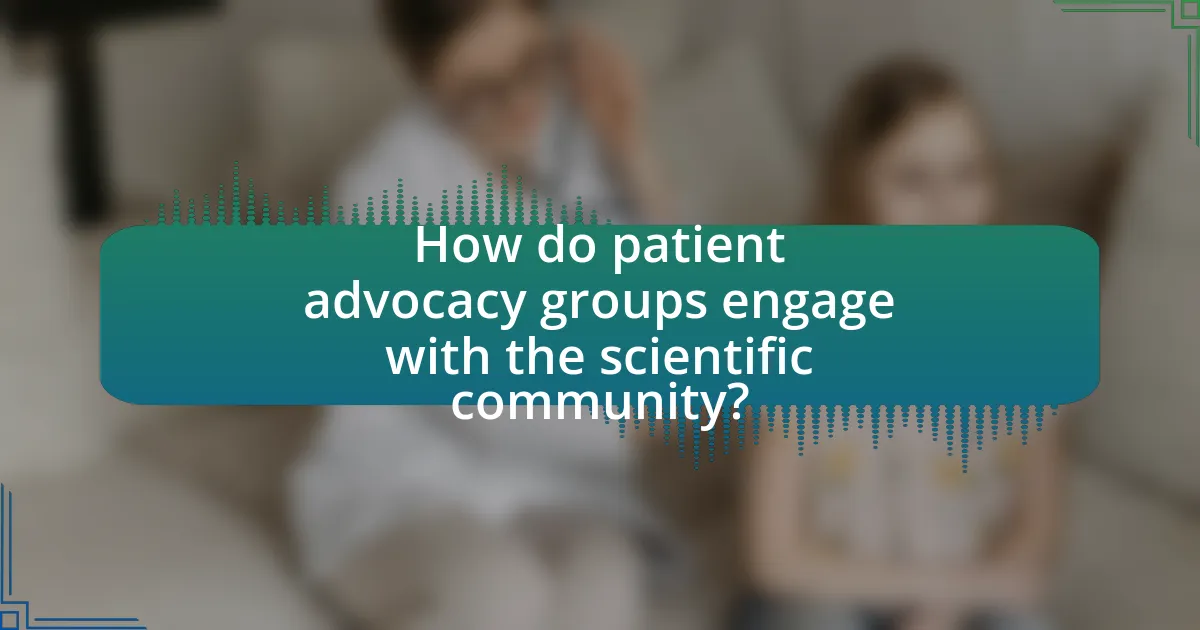
How do patient advocacy groups engage with the scientific community?
Patient advocacy groups engage with the scientific community primarily by facilitating communication between patients, researchers, and healthcare professionals. These groups often organize conferences, workshops, and forums that bring together stakeholders to discuss research priorities, share patient experiences, and promote collaborative research efforts. For instance, the National Organization for Rare Disorders (NORD) has been instrumental in connecting patients with researchers to advance studies in rare diseases, demonstrating the effectiveness of such engagement in influencing research agendas and funding opportunities.
What strategies do patient advocacy groups use to promote gene therapy research?
Patient advocacy groups employ several strategies to promote gene therapy research, including raising awareness, funding research initiatives, and influencing policy. These groups often organize campaigns to educate the public and stakeholders about the potential benefits of gene therapy, thereby increasing interest and support for research. For instance, organizations like the National Organization for Rare Disorders (NORD) advocate for funding and legislative support, which can lead to increased investment in gene therapy projects. Additionally, patient advocacy groups frequently collaborate with researchers and pharmaceutical companies to facilitate clinical trials, ensuring that patient perspectives are integrated into the research process. This collaborative approach not only enhances the relevance of the research but also helps secure necessary funding and resources.
How do patient advocacy groups facilitate patient participation in clinical trials?
Patient advocacy groups facilitate patient participation in clinical trials by providing education, resources, and support to patients. These organizations often disseminate information about ongoing trials, helping patients understand the benefits and risks involved, which increases awareness and interest in participation. For instance, groups like the National Organization for Rare Disorders (NORD) actively connect patients with clinical trial opportunities, enhancing recruitment efforts. Additionally, they advocate for patient-centric trial designs, ensuring that studies address the needs and concerns of patients, which can lead to higher enrollment rates. Research indicates that trials with strong patient advocacy involvement often see improved patient engagement and retention, demonstrating the critical role these groups play in the clinical research landscape.
What role do educational initiatives play in advocacy efforts?
Educational initiatives are crucial in advocacy efforts as they empower individuals with knowledge and awareness about specific issues, particularly in the context of gene therapy research. By providing accurate information and resources, these initiatives help patients and their families understand complex medical concepts, treatment options, and the importance of advocacy in influencing research priorities. For instance, patient advocacy groups often conduct workshops and seminars that educate stakeholders about the potential benefits and risks of gene therapies, thereby fostering informed discussions and decision-making. This educational approach has been shown to enhance patient engagement and mobilize community support, ultimately leading to more effective advocacy outcomes in shaping research agendas and funding priorities.
How do patient advocacy groups collaborate with researchers and industry?
Patient advocacy groups collaborate with researchers and industry by facilitating communication, providing patient insights, and influencing research priorities. These groups often engage in partnerships that allow them to share valuable patient experiences and needs, which can guide the development of research agendas and clinical trials. For instance, the National Organization for Rare Disorders (NORD) has worked with pharmaceutical companies to ensure that the voices of patients are included in the drug development process, leading to more relevant and effective therapies. Additionally, patient advocacy groups may help in recruiting participants for clinical trials, thereby accelerating the research process and ensuring that studies are more representative of the patient population.
What partnerships are formed between patient advocacy groups and biotech companies?
Partnerships between patient advocacy groups and biotech companies often focus on collaborative research initiatives, funding for clinical trials, and the development of patient-centered therapies. These partnerships enable biotech companies to gain insights into patient needs and preferences, while advocacy groups benefit from access to resources and expertise in drug development. For example, the collaboration between the Cystic Fibrosis Foundation and Vertex Pharmaceuticals led to the development of breakthrough therapies, demonstrating how such partnerships can accelerate innovation and improve treatment outcomes for patients.
How do these collaborations impact the development of gene therapies?
Collaborations between patient advocacy groups and researchers significantly accelerate the development of gene therapies by ensuring that patient needs and perspectives are integrated into the research process. These partnerships facilitate the identification of relevant therapeutic targets and help prioritize research efforts based on the most pressing patient concerns. For instance, advocacy groups often provide critical insights into the lived experiences of patients, which can guide the design of clinical trials and the selection of endpoints that matter most to patients. This alignment not only enhances the relevance of the research but also fosters greater engagement from the patient community, leading to increased recruitment and retention in clinical studies. Additionally, collaborations can enhance funding opportunities, as advocacy groups often mobilize resources and support from donors who are passionate about specific diseases, thereby accelerating the overall timeline for bringing gene therapies to market.
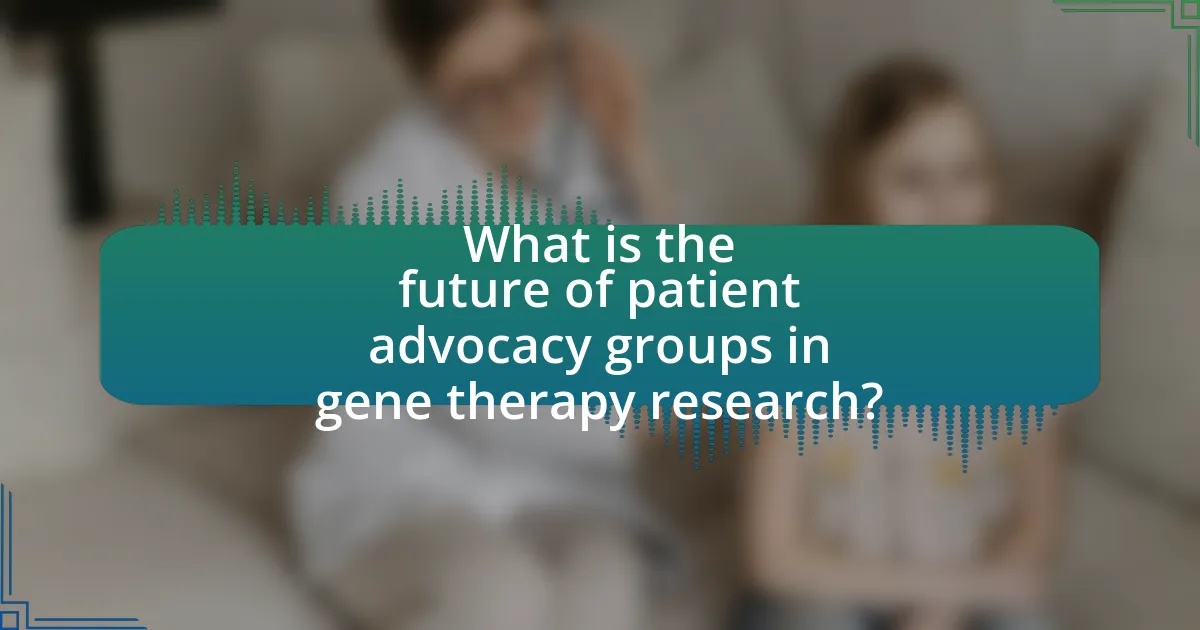
What is the future of patient advocacy groups in gene therapy research?
The future of patient advocacy groups in gene therapy research is poised to become increasingly influential as they drive patient-centered initiatives and foster collaboration among stakeholders. These groups are expected to play a critical role in shaping research priorities, ensuring that the needs and perspectives of patients are integrated into the development of gene therapies. For instance, the National Organization for Rare Disorders (NORD) has demonstrated how advocacy groups can effectively mobilize resources and support for rare disease research, highlighting the importance of patient input in clinical trial design and regulatory processes. As gene therapy continues to evolve, patient advocacy groups will likely enhance their impact by leveraging data, promoting awareness, and advocating for equitable access to innovative treatments.
How might the role of patient advocacy groups evolve in the coming years?
The role of patient advocacy groups is likely to evolve towards greater influence in shaping gene therapy research and policy. As advancements in gene therapy continue, these groups will increasingly serve as vital intermediaries between patients, researchers, and regulatory bodies, advocating for patient-centric approaches in clinical trials and treatment accessibility. Their growing involvement is supported by the increasing recognition of patient perspectives in research, as evidenced by initiatives like the FDA’s Patient Engagement Advisory Committee, which emphasizes the importance of patient input in drug development processes. This trend indicates that patient advocacy groups will play a crucial role in ensuring that gene therapy advancements align with the needs and preferences of the patient community.
What emerging trends could influence patient advocacy in gene therapy?
Emerging trends that could influence patient advocacy in gene therapy include the rise of personalized medicine, advancements in digital health technologies, and increased collaboration between advocacy groups and researchers. Personalized medicine allows for tailored treatments based on individual genetic profiles, which empowers patient advocacy groups to push for specific therapies that meet the unique needs of their communities. Digital health technologies, such as telemedicine and mobile health applications, enhance communication and engagement between patients and advocacy organizations, facilitating better access to information and resources. Furthermore, collaborative efforts between advocacy groups and researchers foster a more patient-centered approach in gene therapy development, ensuring that patient voices are integral to the research process. These trends collectively enhance the effectiveness and reach of patient advocacy in the evolving landscape of gene therapy.
How can patient advocacy groups adapt to changes in the research landscape?
Patient advocacy groups can adapt to changes in the research landscape by actively engaging in collaborations with researchers, policymakers, and industry stakeholders. This collaboration allows these groups to stay informed about emerging trends and innovations in gene therapy research, enabling them to advocate effectively for patient needs and priorities. For instance, by participating in research consortia or advisory boards, advocacy groups can influence study designs and funding priorities, ensuring that patient perspectives are integrated into the research process. Additionally, leveraging digital platforms for education and outreach helps these groups disseminate information about new therapies and clinical trials, thereby empowering patients to make informed decisions.
What best practices can patient advocacy groups adopt to enhance their impact?
Patient advocacy groups can enhance their impact by fostering collaboration with researchers, healthcare providers, and policymakers. This collaboration allows for the sharing of knowledge and resources, which can lead to more effective advocacy efforts and improved patient outcomes. For instance, a study published in the journal “Health Affairs” highlights that partnerships between advocacy groups and academic institutions can accelerate the translation of research into clinical practice, ultimately benefiting patients. Additionally, advocacy groups should focus on educating their members and the public about gene therapy advancements, as informed stakeholders are more likely to engage in meaningful dialogue and advocacy. By implementing these best practices, patient advocacy groups can significantly amplify their influence in shaping gene therapy research and policy.
How can patient advocacy groups effectively communicate their goals to stakeholders?
Patient advocacy groups can effectively communicate their goals to stakeholders by utilizing clear messaging, targeted outreach, and data-driven narratives. Clear messaging ensures that the objectives of the advocacy group are articulated in a straightforward manner, making it easier for stakeholders to understand the group’s mission and priorities. Targeted outreach involves identifying and engaging specific stakeholders, such as policymakers, healthcare providers, and industry leaders, to foster relationships and facilitate dialogue. Data-driven narratives leverage statistics and research findings to support the group’s goals, demonstrating the impact of their advocacy efforts. For instance, a study published in the Journal of Health Communication highlights that advocacy groups that present compelling data are more likely to influence policy decisions. This combination of clarity, targeted engagement, and evidence-based communication enhances the effectiveness of patient advocacy groups in conveying their goals to stakeholders.
What strategies can improve patient engagement in gene therapy research?
Strategies to improve patient engagement in gene therapy research include enhancing communication, fostering collaboration, and providing education. Effective communication ensures that patients understand the research process and its implications, which can be achieved through clear, accessible information and regular updates. Collaboration with patient advocacy groups allows researchers to incorporate patient perspectives and needs into study designs, making the research more relevant and patient-centered. Additionally, educational initiatives that inform patients about gene therapy, its potential benefits, and risks can empower them to participate actively in research discussions. Evidence shows that when patients are well-informed and involved, they are more likely to engage meaningfully in research, leading to better outcomes and increased trust in the research process.
